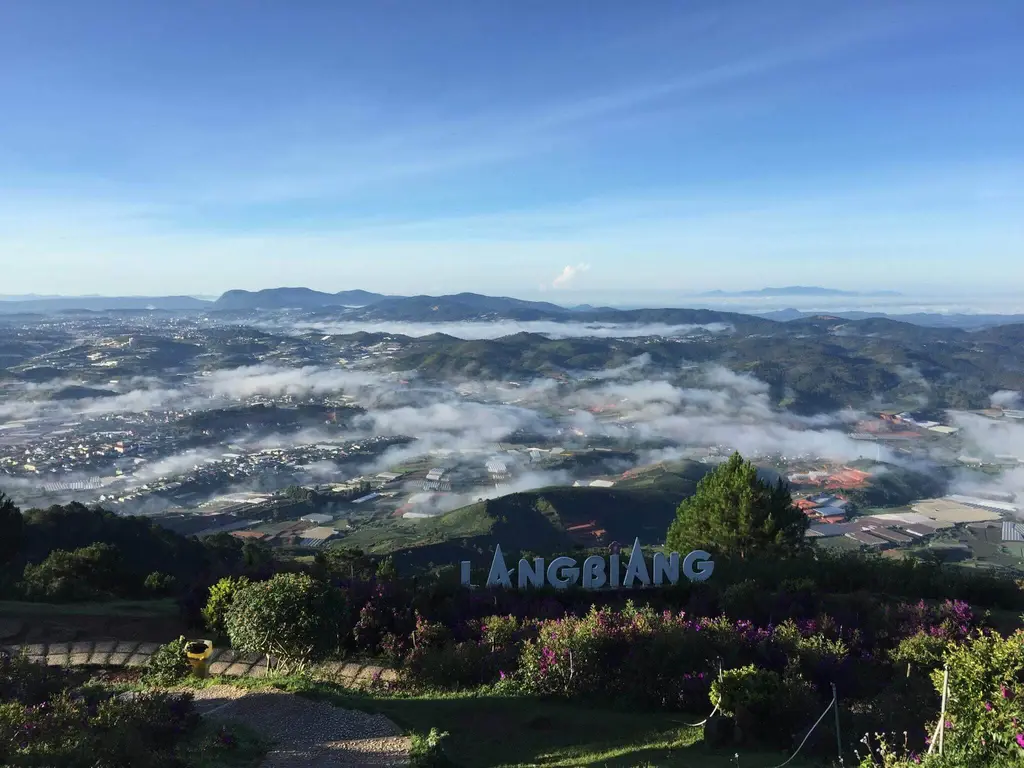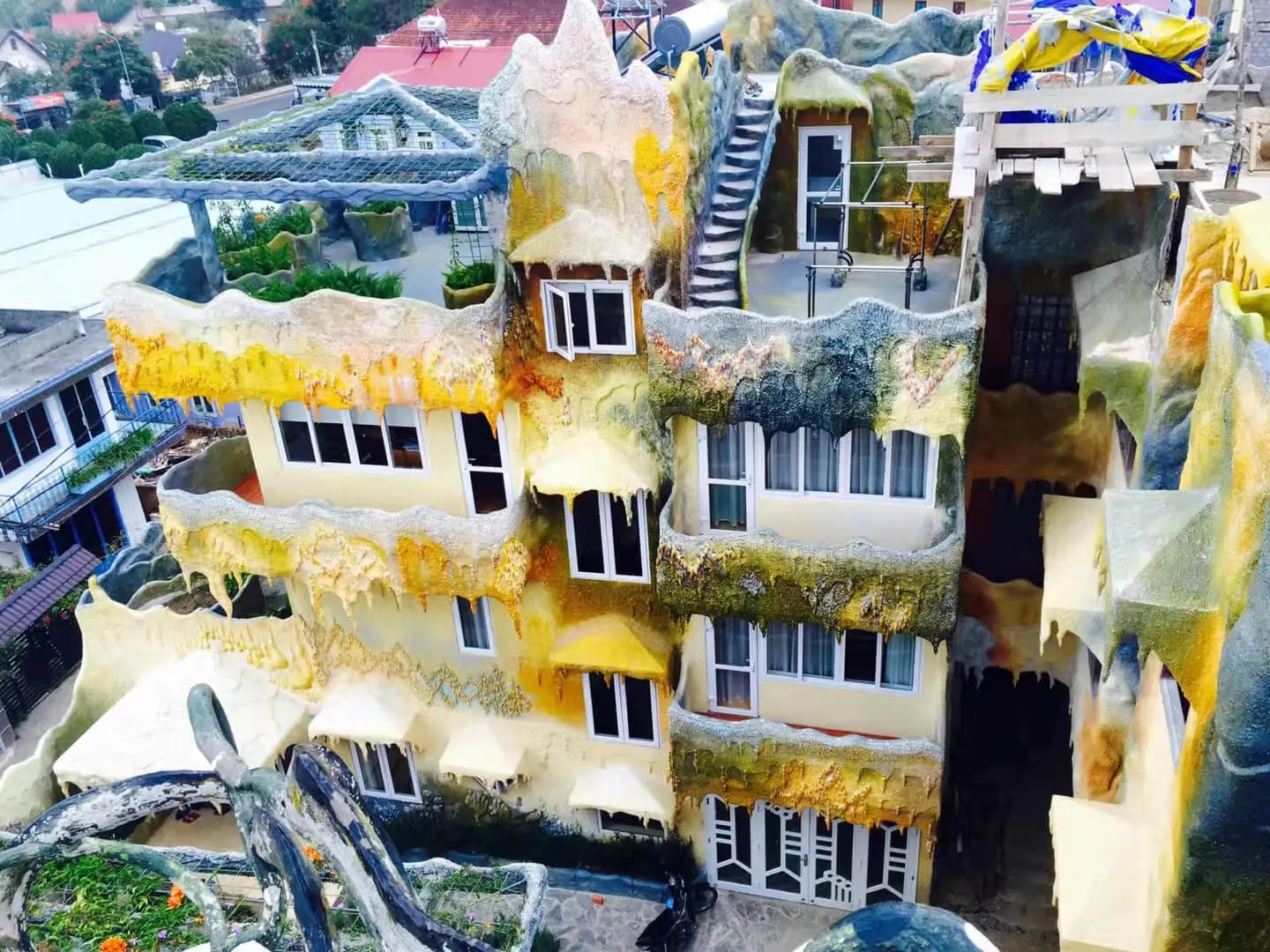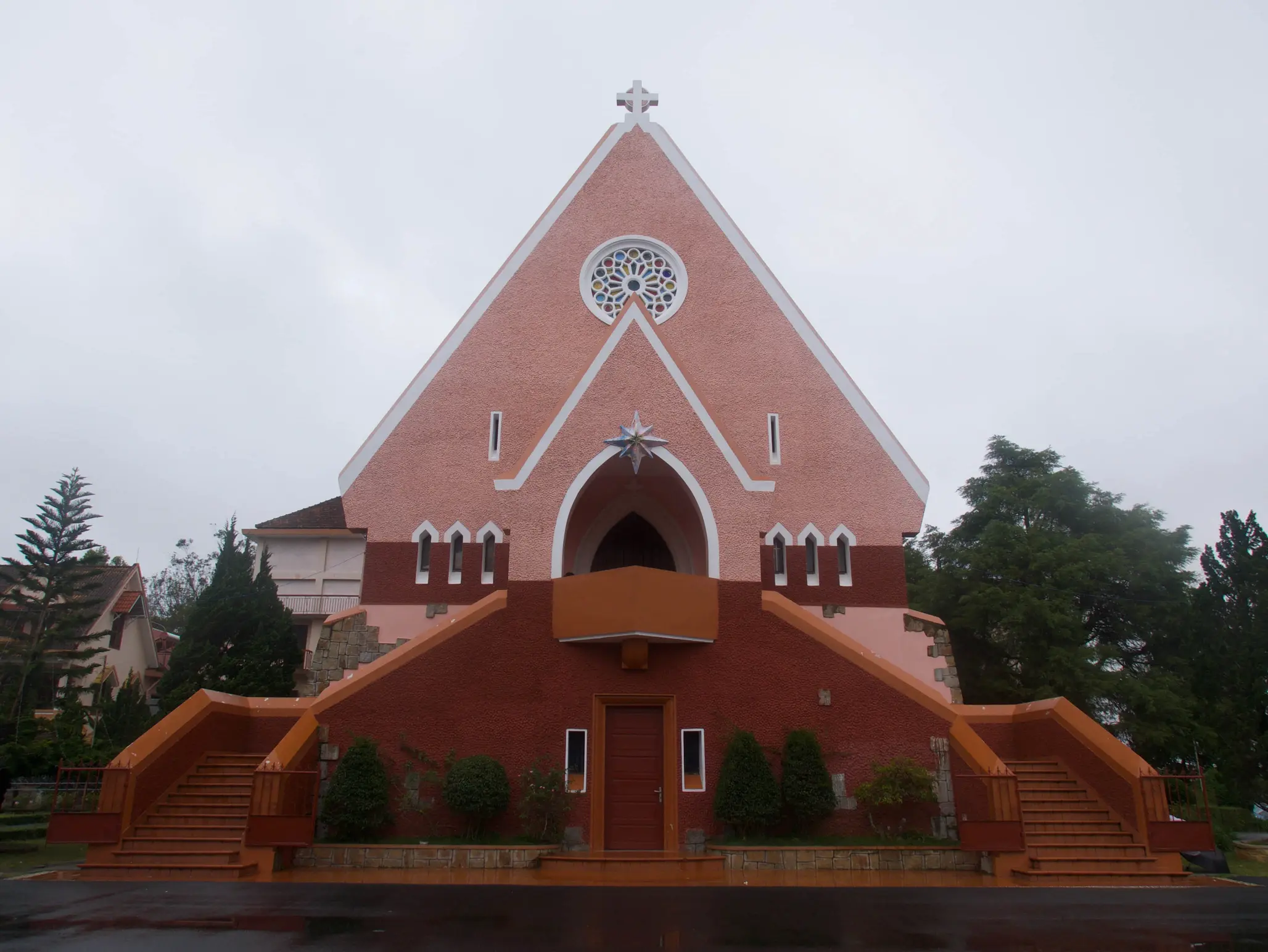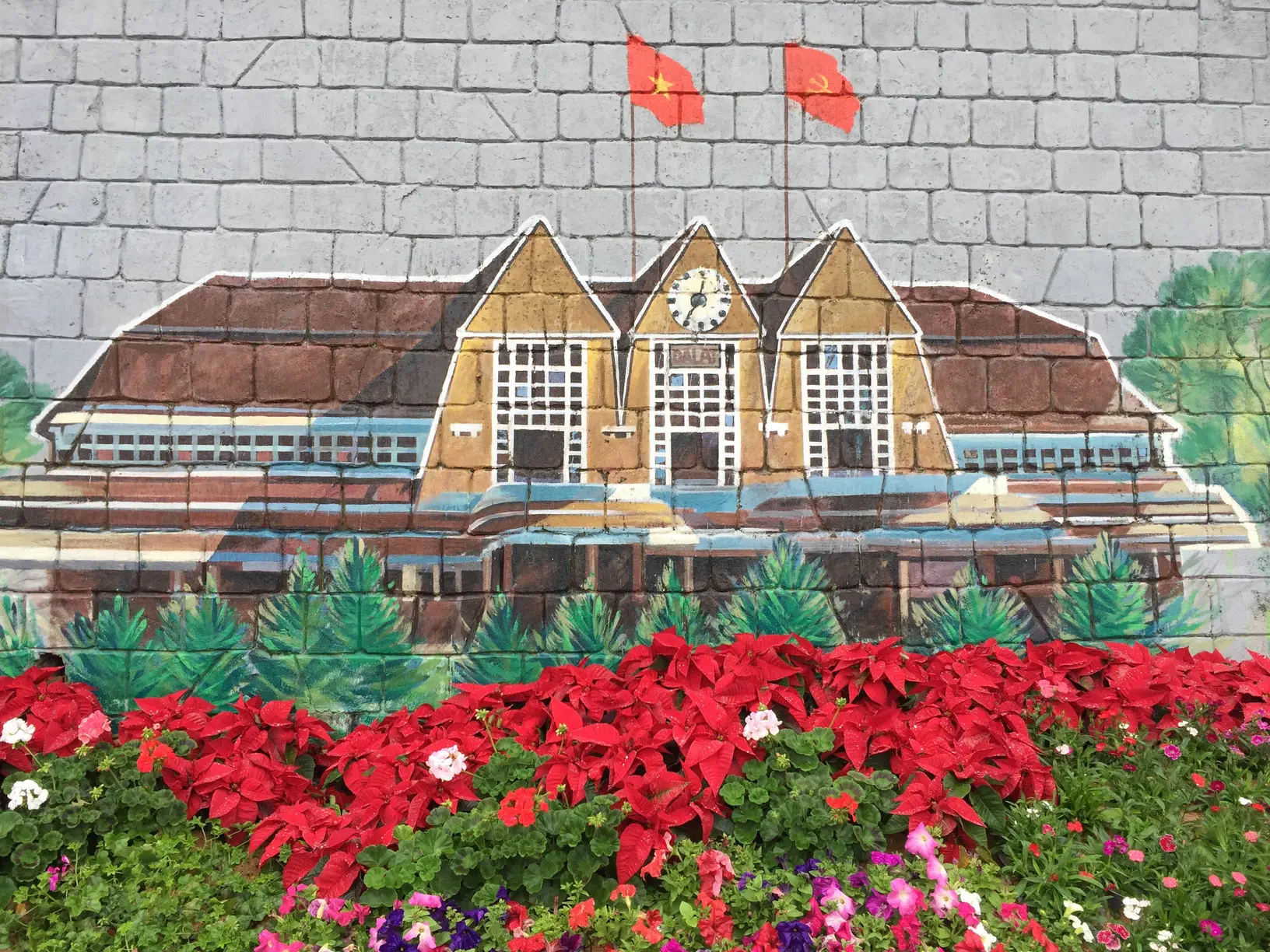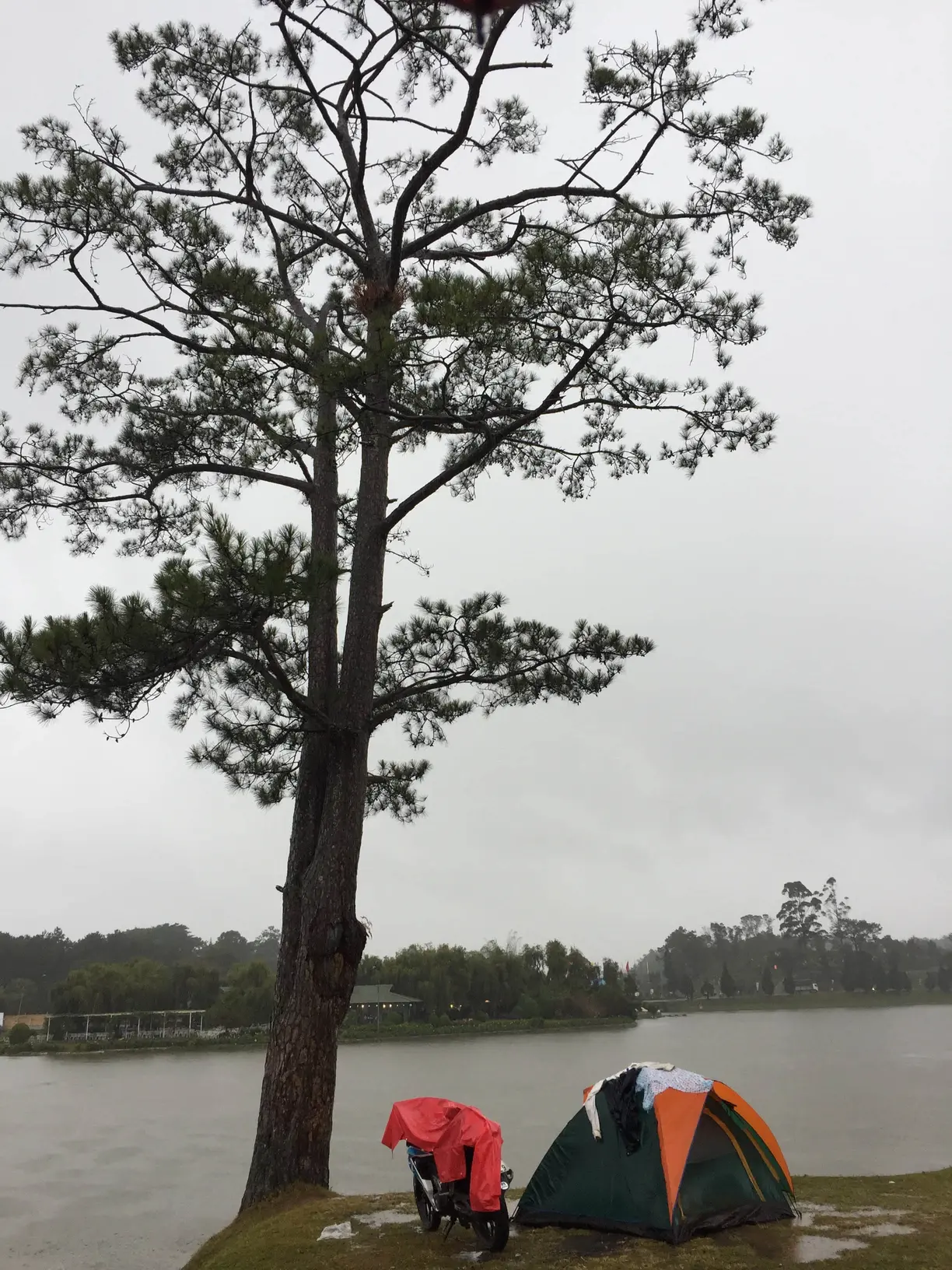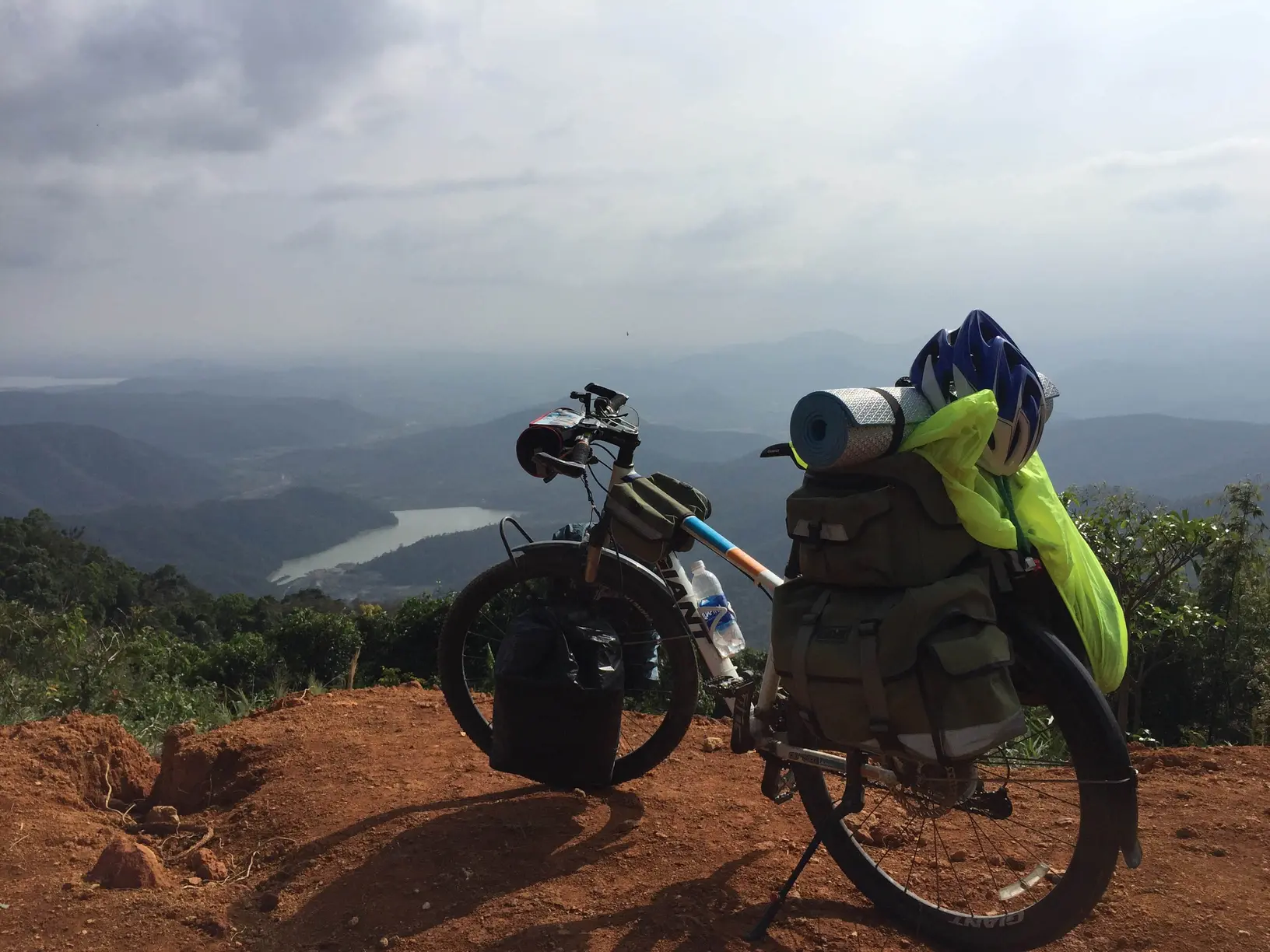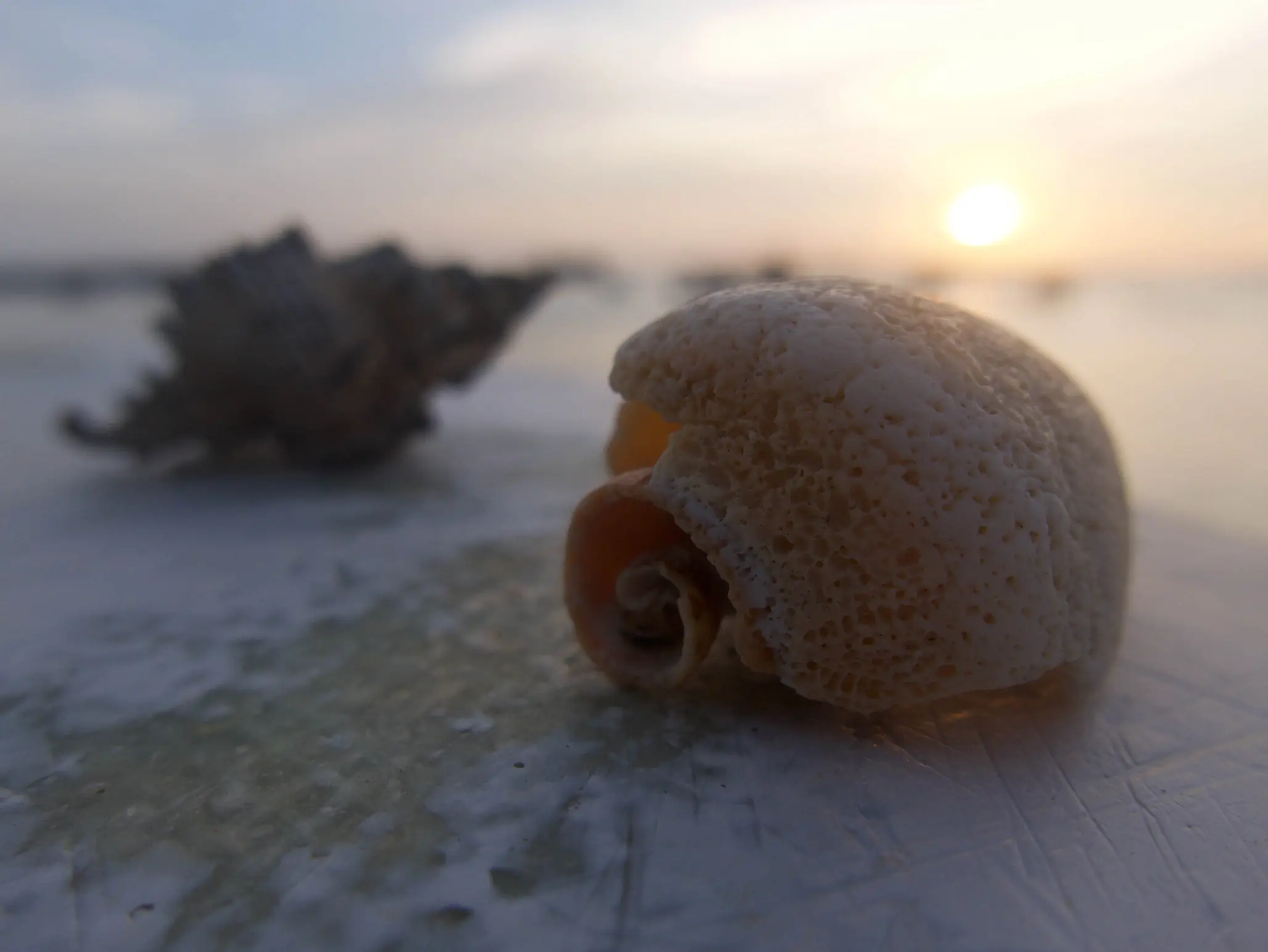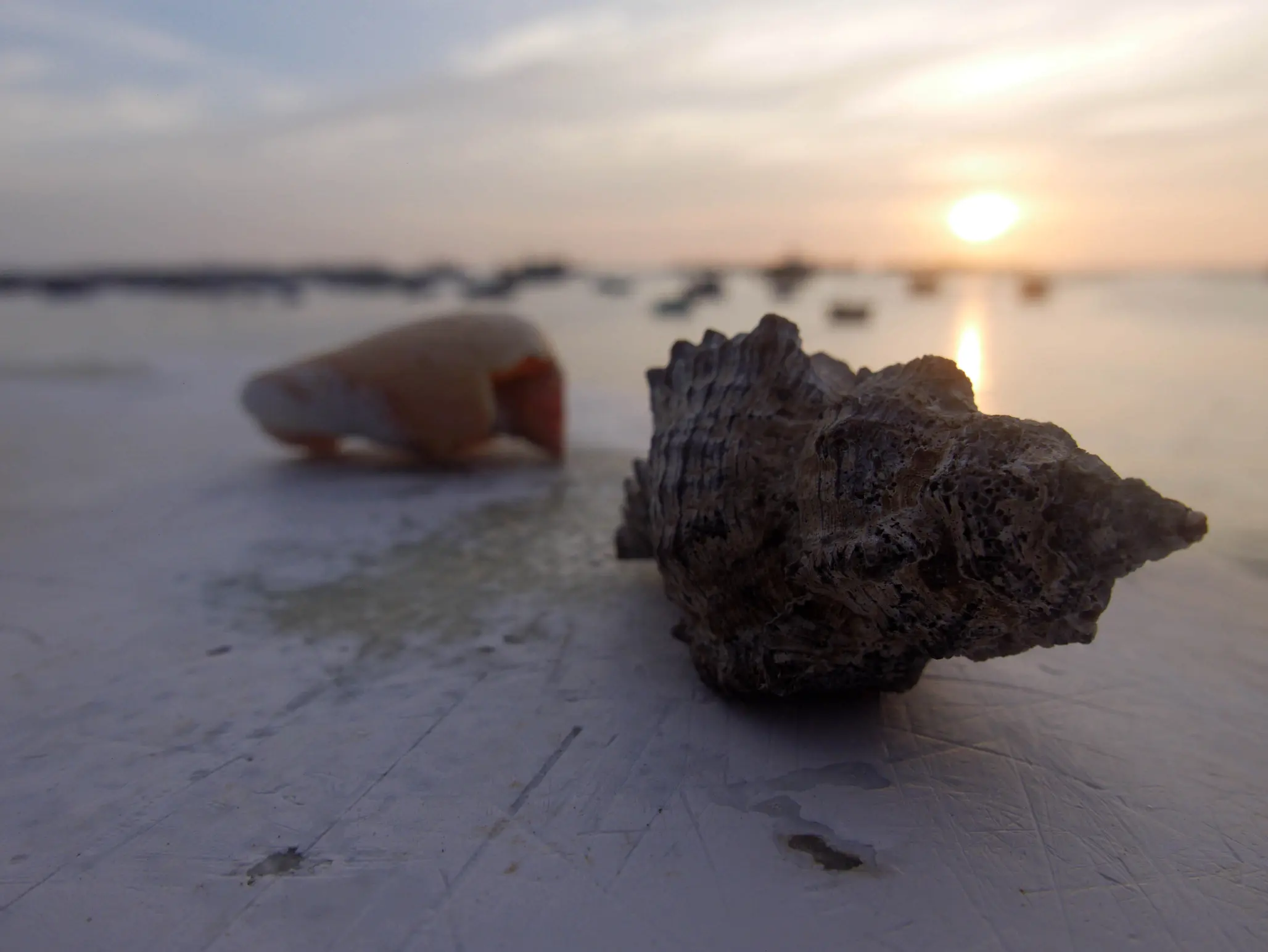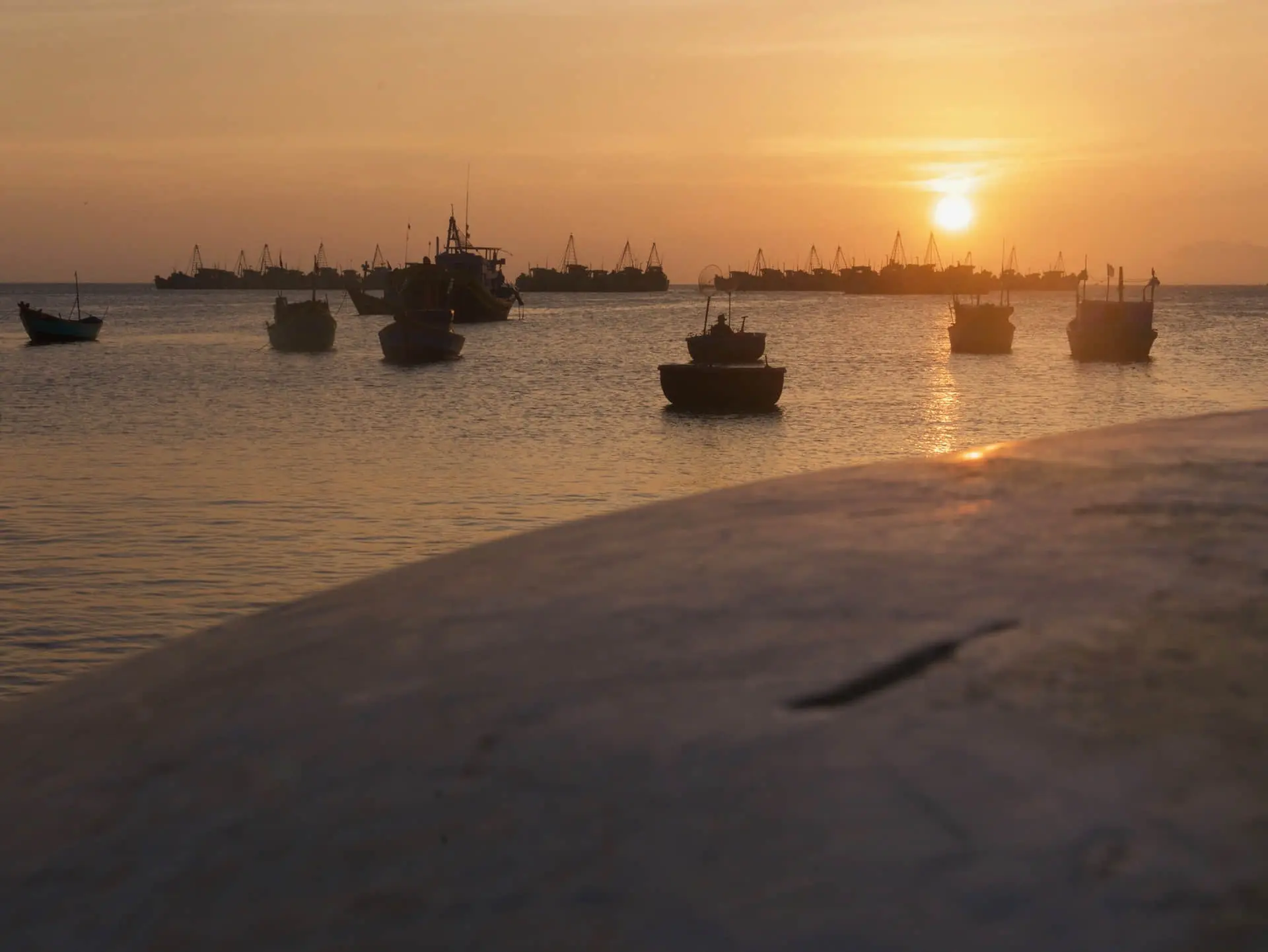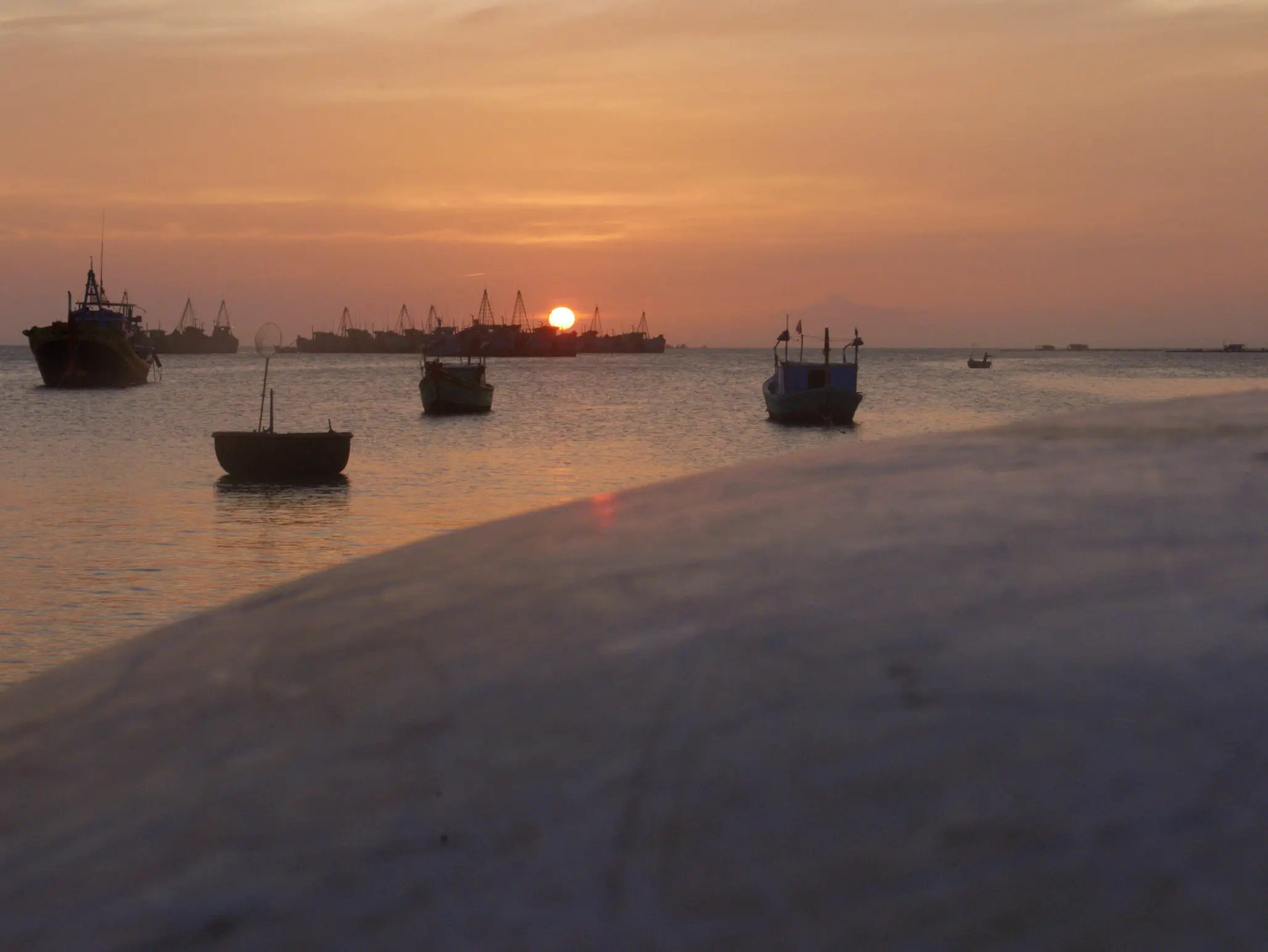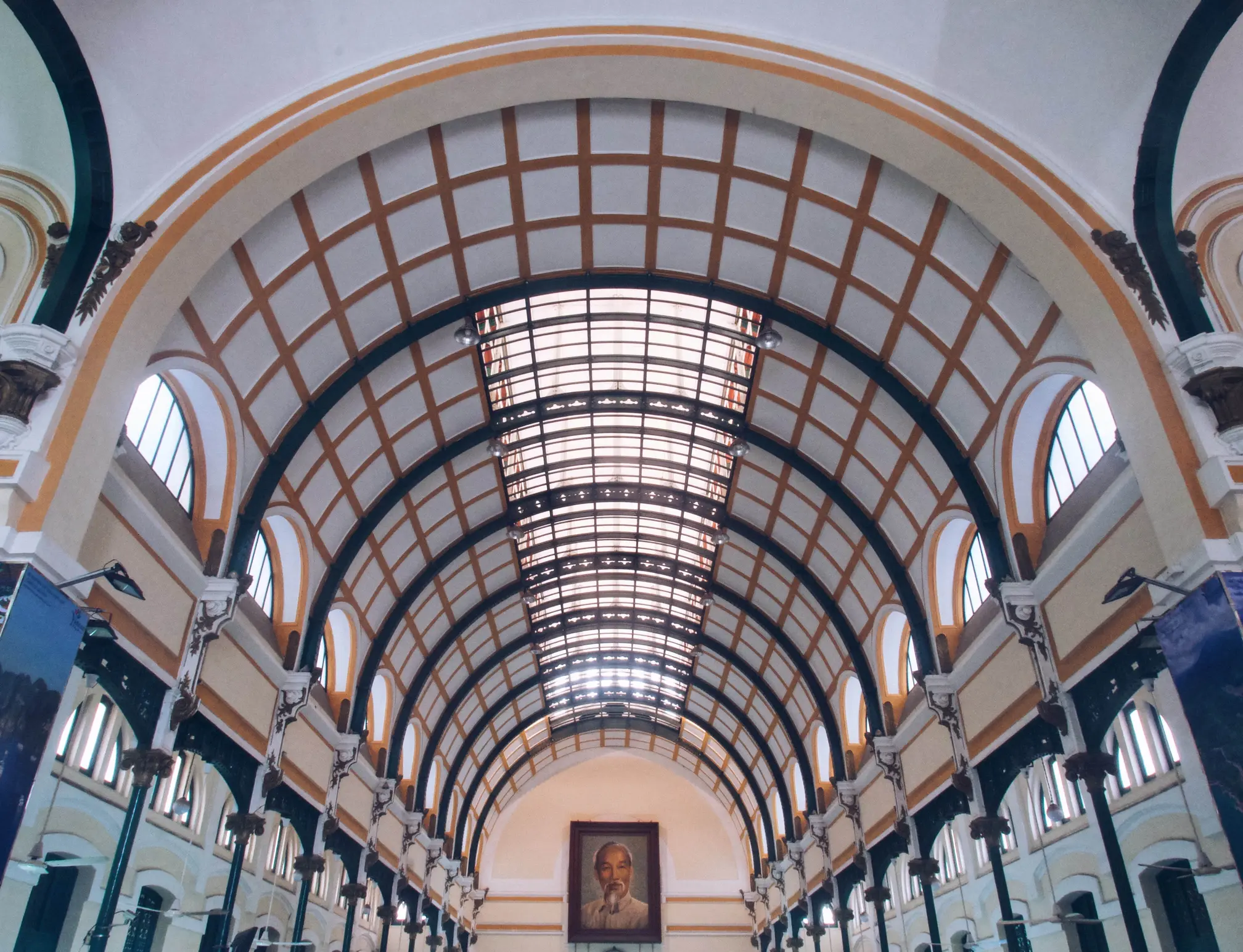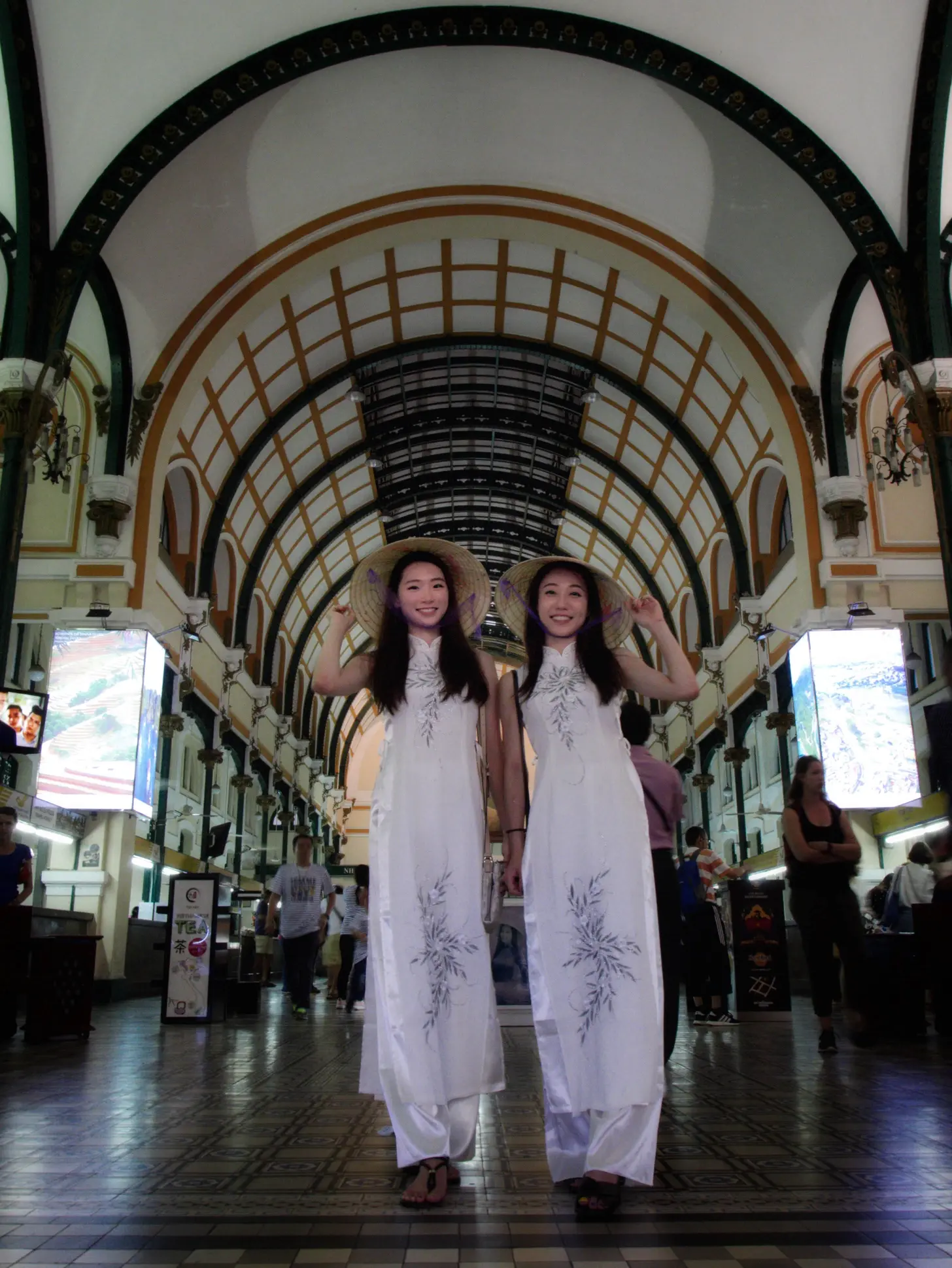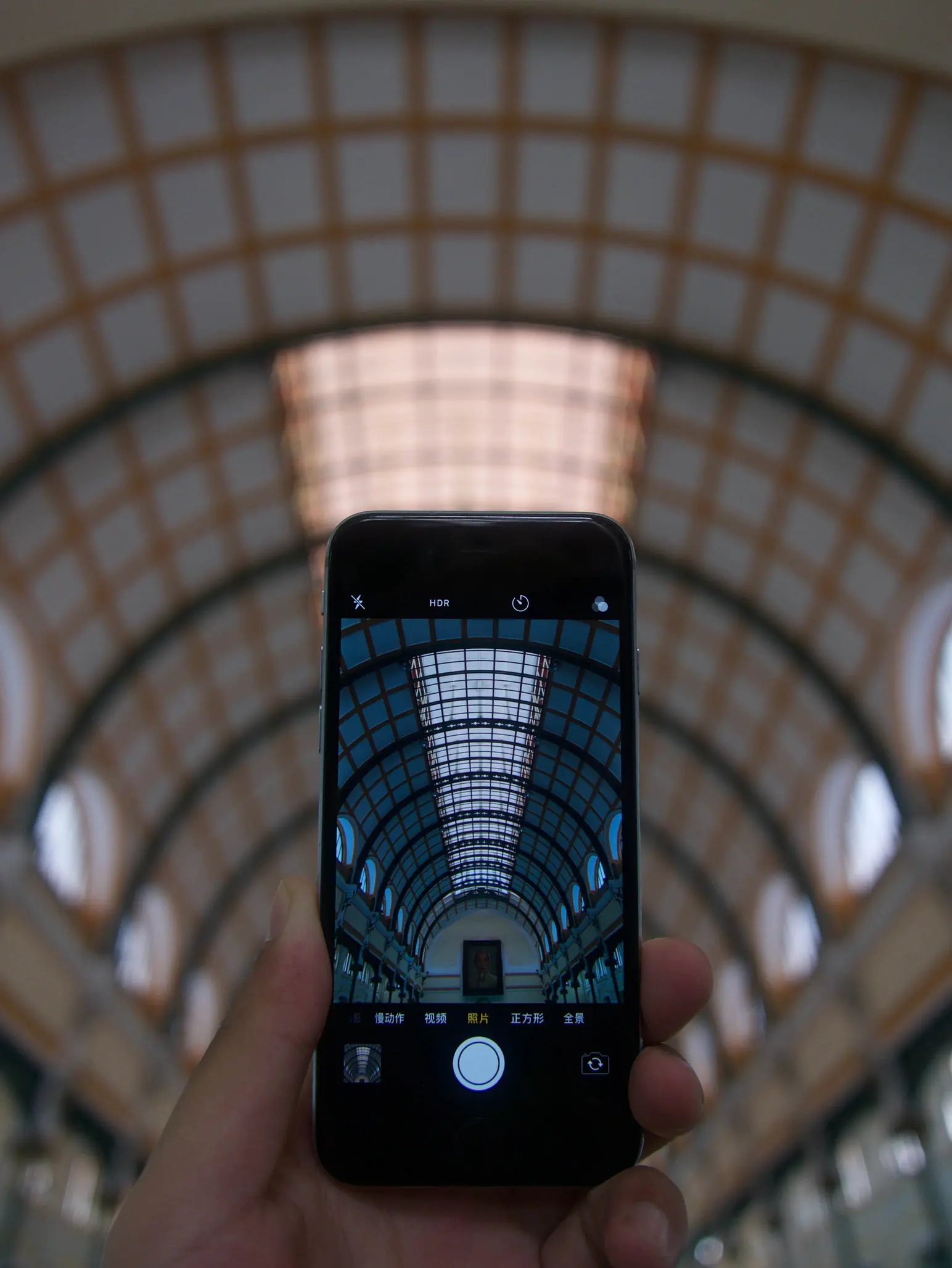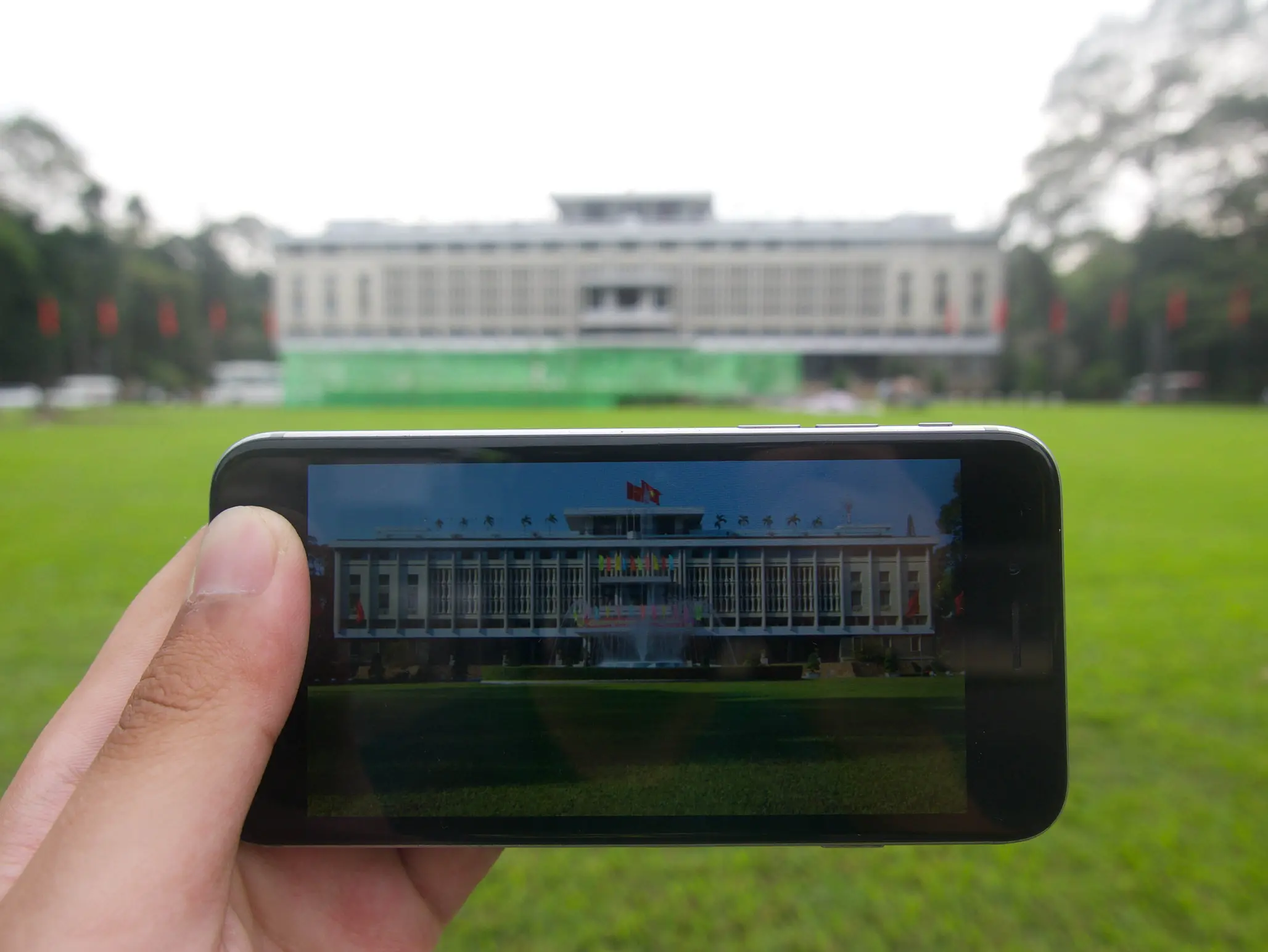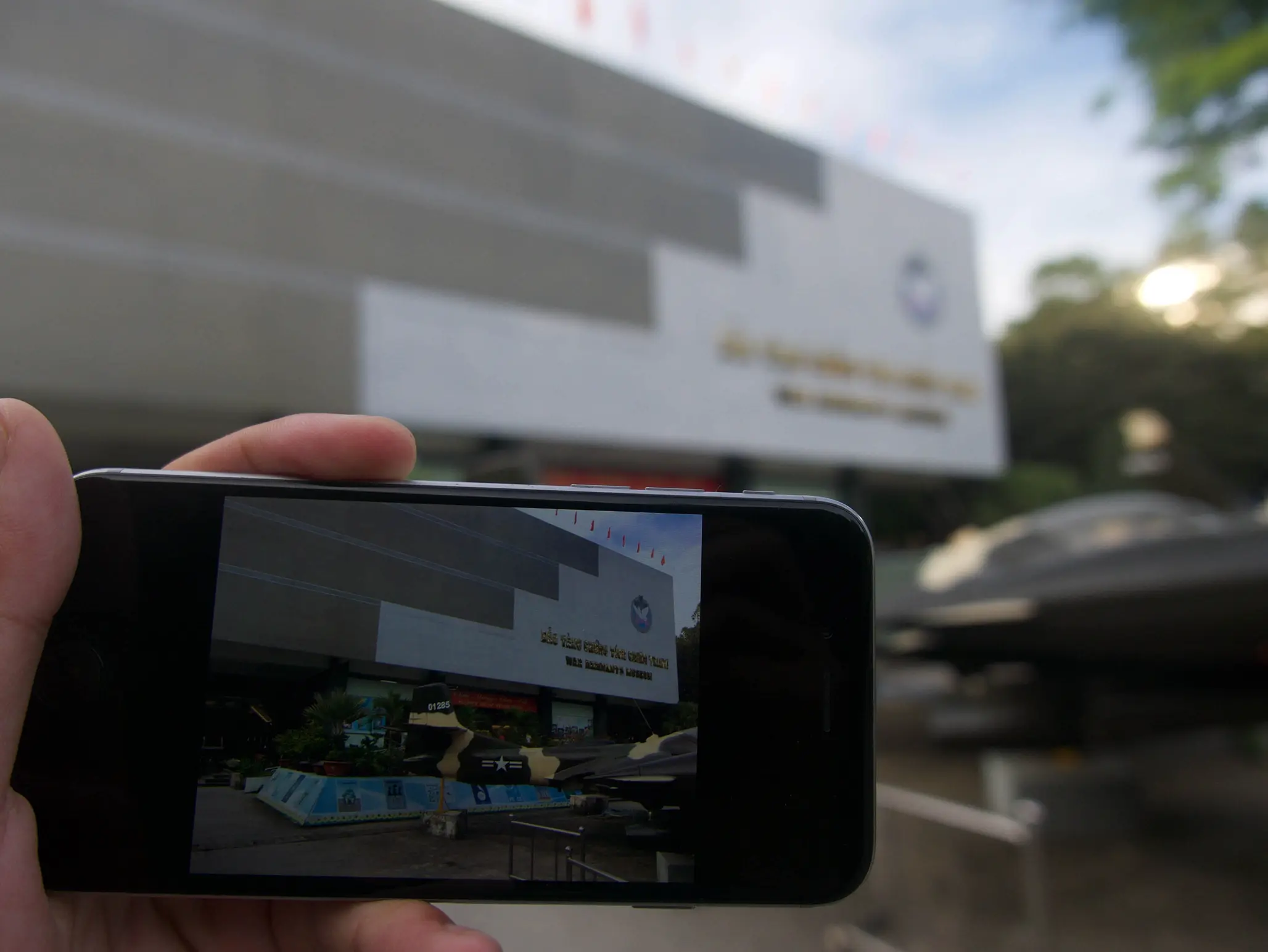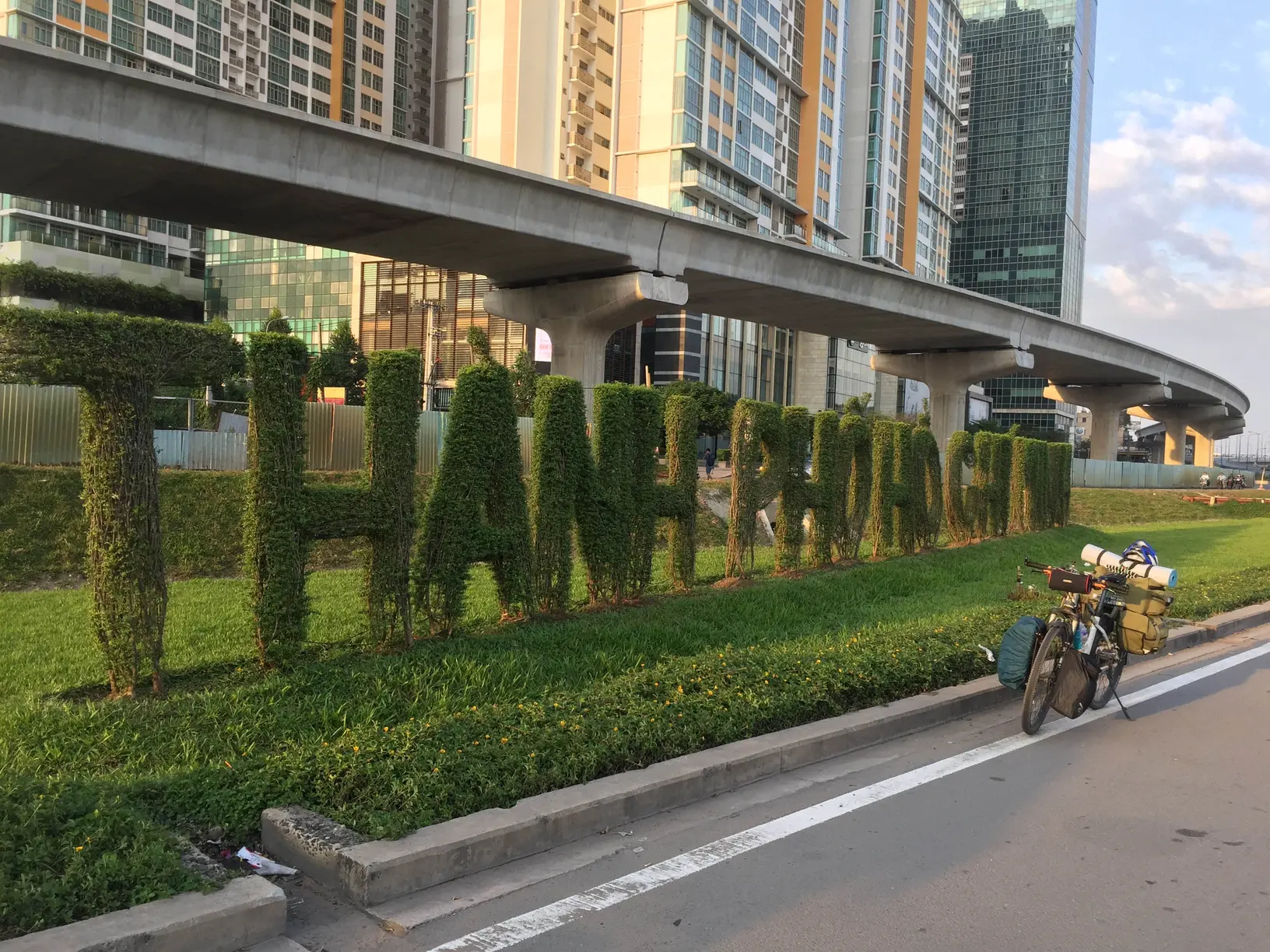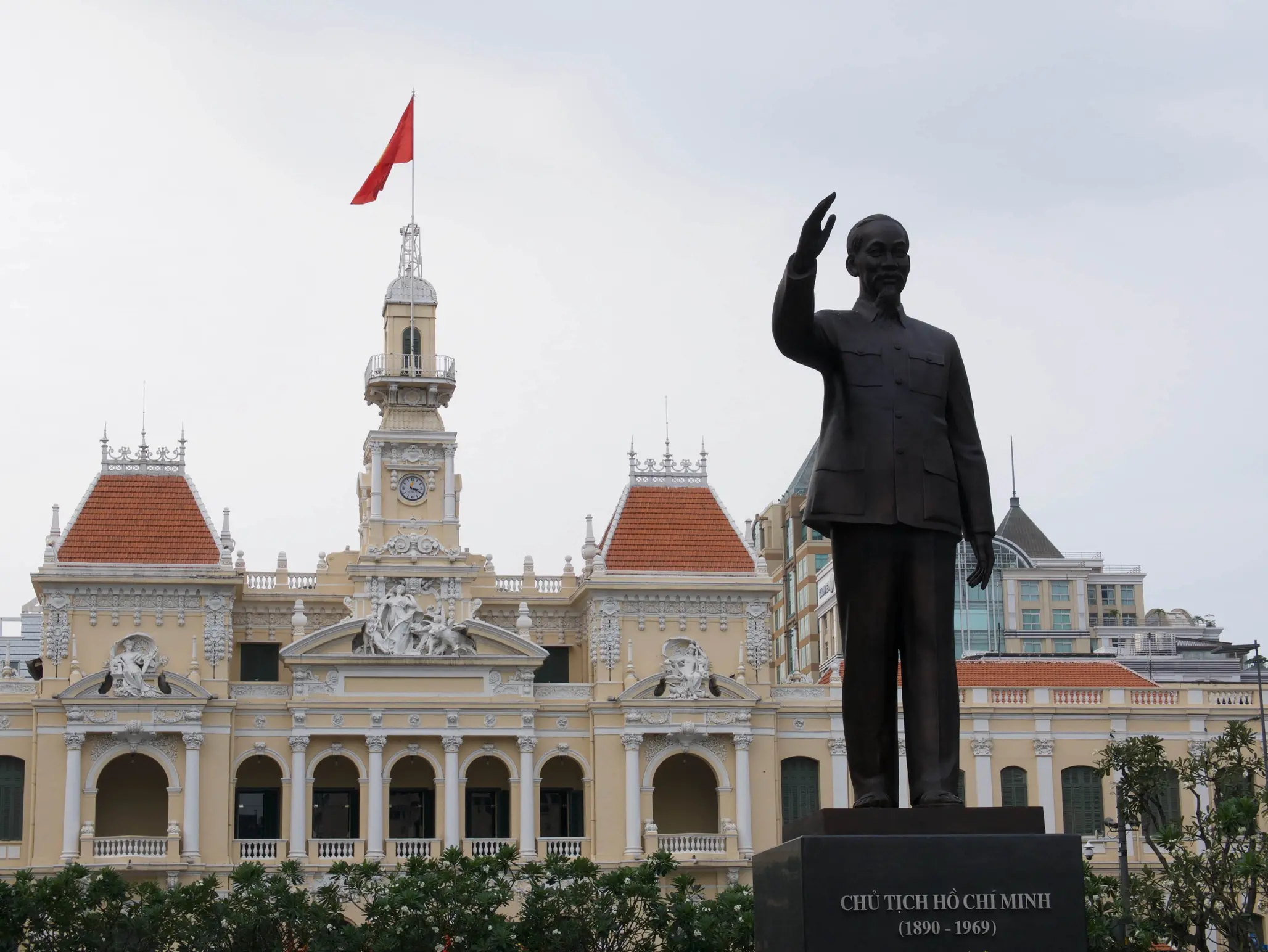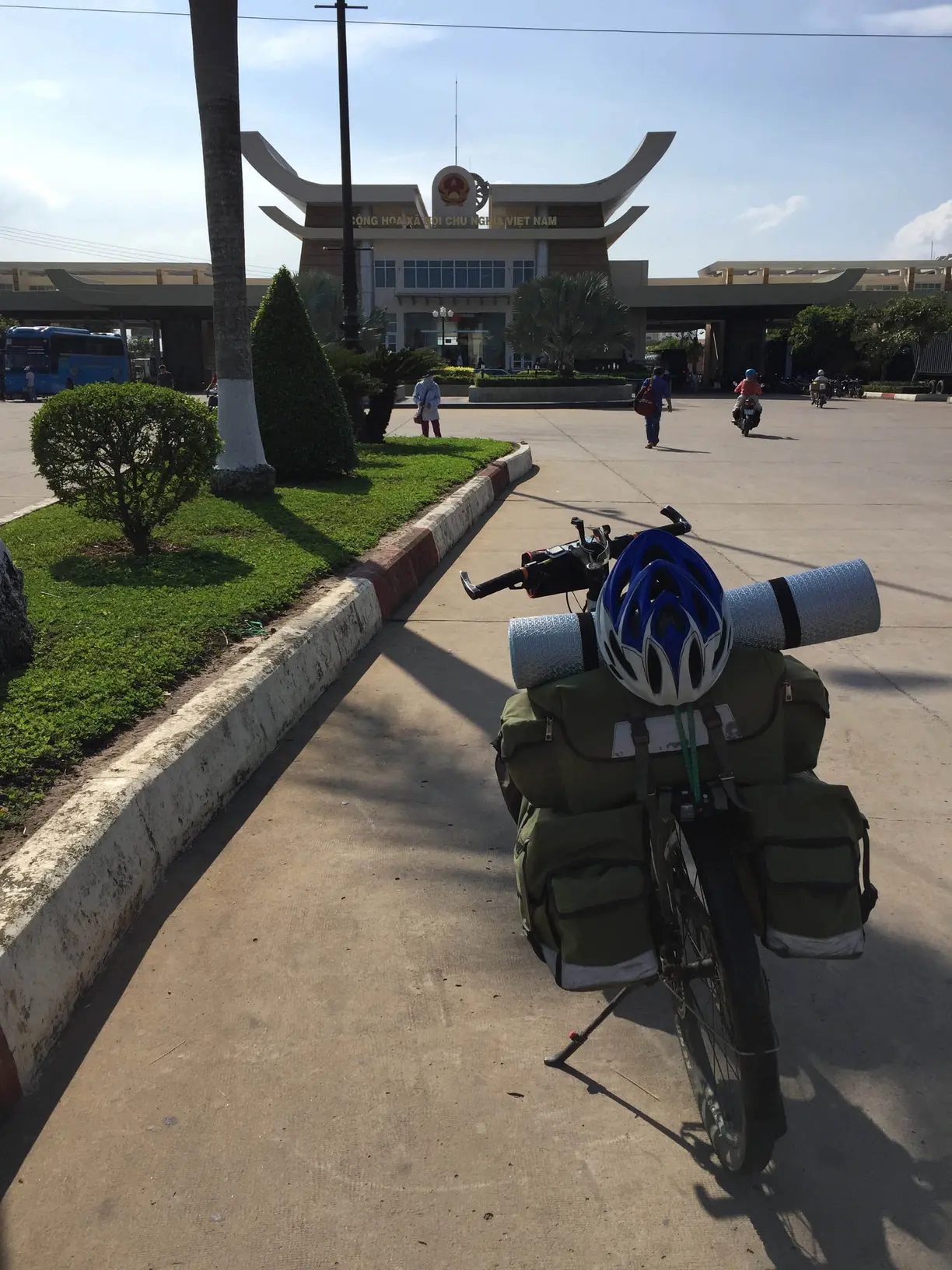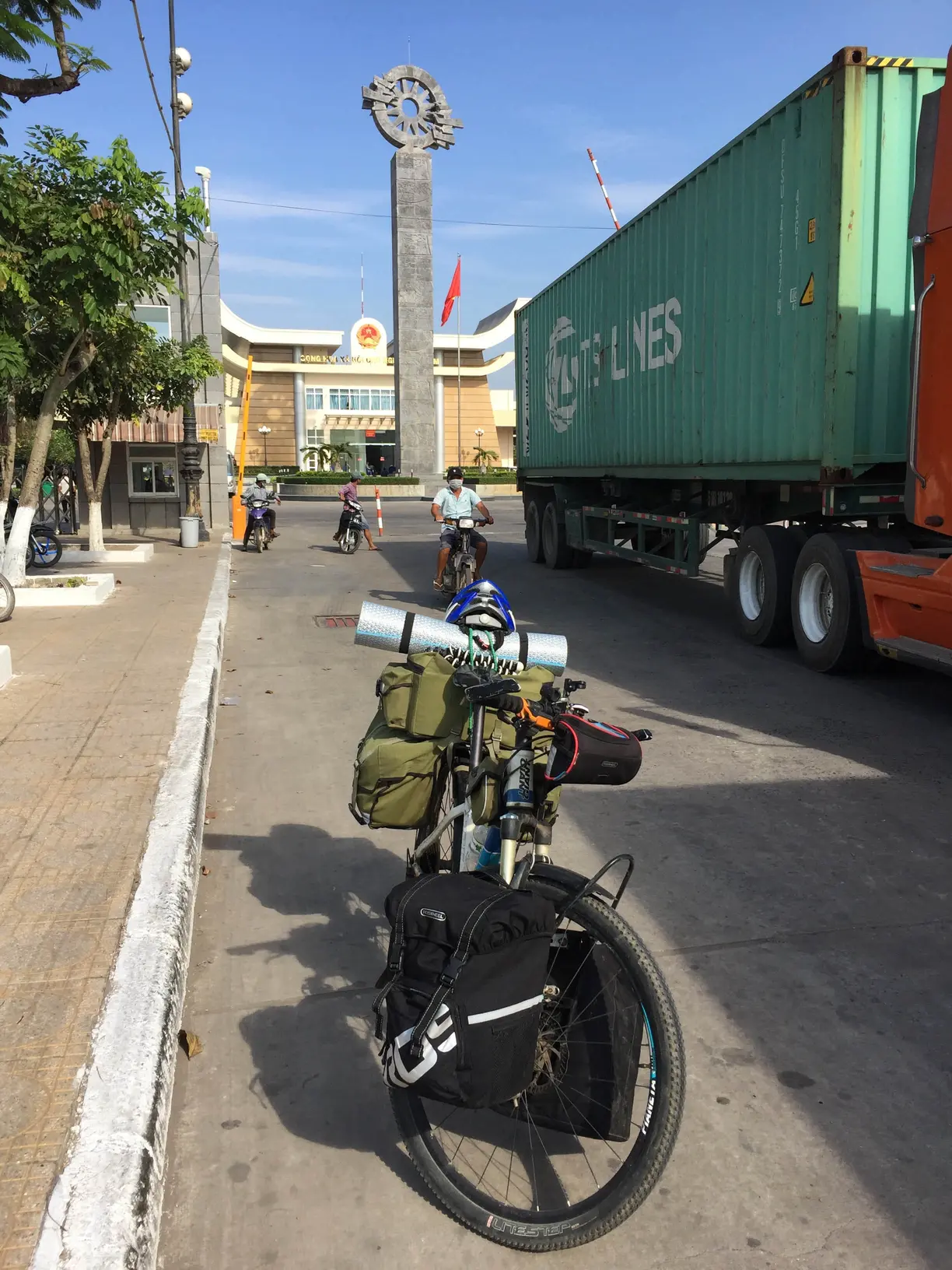13
In the morning, around 8 o’clock, my roommates had already left for work. I was vaguely aware of their departure but too sleepy to greet them, so I rolled over and went back to sleep. I slept until past 9 o’clock. The elder sister who was left behind called me to have some breakfast. Afterwards, I repaired the punctured tire, inflated it, packed my saddlebags, and bid farewell.
The weather wasn’t great, with hazy fog and intermittent drizzle. Some sections of the road had small mudslides. Surprisingly, I hadn’t reached the mountaintop after riding for seven to eight kilometers. I silently rejoiced that I didn’t continue riding yesterday, as the situation would have been even worse. I passed by the road repair site where Le Huy Vọng and the others were working. They greeted me from afar, and for a moment, the sound of forklifts, truck horns, and people calling out filled the air. I thanked them one by one and continued riding toward the mountaintop.
After reaching the mountaintop, there wasn’t anything particularly special, and I couldn’t be bothered to take out my phone for photos. But I felt a sense of relief deep inside. The downhill stretch was just around the corner, and I could happily speed down. However, my joy was short-lived. After descending for five to six kilometers, I reached the bottom, and ahead of me were undulating roads, undulating roads, and more undulating roads…
When I was about ten kilometers away from Dalat, the rain intensified, so I took shelter in a roadside shop. Two customers who were visiting the shop showed great interest in me and asked about my age, experiences, and the various places I had passed through. They had regular business dealings with Chinese merchants and had many Chinese friends, so they could speak some simple Chinese. The man took out a pack of Zhonghua cigarettes and asked me, “Is this the best cigarette in China?” I nodded, and he grinned, taking one out and handing it to me while putting another in his own mouth, saying, “These were all given by Chinese friends.”
After the rain subsided, I put on my raincoat and continued my journey. After making a sharp turn, the scenery suddenly opened up, and Dalat appeared before me. At that moment, the sunlight broke through the clouds and cast rays of light, illuminating the colonial villas that were densely scattered among the mountains. The colorful villas added vitality to this tranquil valley. If I weren’t so physically exhausted, I would have loved to stay a little longer and take in the view.
Throughout the journey, there weren’t many people or vehicles. But as I approached the urban area of Dalat, a multitude of people and motorcycles seemed to emerge from everywhere. I followed the crowd and arrived in Dalat.
Dalat served as the summer residence of Emperor Bảo Đại, similar to Chengde in China. It was currently hosting a Flower Festival, with various flowers decorating the roadsides and a huge flower float erected in the square. I rode past Dalat Railway Station, crossed Spring Fragrance Lake, and arrived at the hotel I had booked. The hotel was located by a quiet river, away from the bustling city center, and it was peaceful with few people around.
I parked my bicycle in the hotel courtyard, unloaded my luggage, took a shower, and washed my clothes. Then, I went out for a stroll.
Dalat is situated in the Central Highlands of southwestern Vietnam, and its name means “the river of the Lat tribe” in the local language. The weather in Dalat is like spring all year round. The French, who originally lived in Saigon, came here to escape the summer heat. They brought with them vacation villas, European influences, and abundant coffee plantations. During the Vietnam War, thanks to a series of treaties, Dalat was spared from the ravages of war, allowing its unique charm to be preserved.
Before reaching Dalat, I had already heard about a famous attraction called the Crazy House. It’s an imaginative architectural masterpiece designed by the daughter of a former Vietnamese prime minister. Originally a private residence, it gradually opened to the public and even operates as a hotel.
Following the map, I arrived at the entrance of the Crazy House, purchased a ticket, and entered along with other curious tourists from different places. My first impression was that it was bright, vibrant, and unique. Narrow bridges connected the scattered rooms, and each room had its own distinctive features. Even surrounded by lush greenery, their exaggerated shapes still caught the eye. Some resembled ghosts, others animals, and some displayed twisted imagery. Walking on the bridges required caution. If someone approached from the other end, you had to find a way to avoid each other, either by stepping aside or retreating to let the other person pass. After exploring every corner and taking some photos, I was ready to move on to the next destination.
As I exited the Crazy House, the sky started drizzling. I roughly identified the direction and leisurely strolled through various unfamiliar streets and alleys until I reached the shores of Spring Fragrance Lake. The lake, shaped like a crescent moon, is an artificial lake dug during the French colonial era in the 20th century. It takes its name from a Vietnamese female poet. Surrounding the lake is a picturesque circular path. I opened my umbrella and walked along this path.
When I reached the middle section, I noticed a tent pitched beneath a tall tree by the lake, with a motorcycle parked nearby. There were no other trees around, just this solitary one. I approached and saw the tent’s entrance curtain was open. A young man, shirtless, was squatting and wringing out his wet clothes, then draping them over the tent. I thought to myself, it’s still raining, so what’s the point of drying them like this?
I asked him where he came from and if he was traveling to Dalat. His English was not very good, and we struggled to communicate for a while. I learned that he wasn’t a tourist nor a local. He had ridden his motorcycle from somewhere and ended up staying there.
I returned to the pathway, and by now, the rain was pouring heavily. Before long, my shoes were soaked. The motorcyclists on the road seemed anxious, revving their engines and hurrying along. Suddenly, there was a sharp “clang” sound. A motorcycle taking a turn too quickly tipped over, and the rider was thrown off, leaving a long skid mark on the ground. I dropped my umbrella and ran to the rider, asking if he was okay. He was a young man, seemingly a white-collar worker, dressed in a fitted suit that was now torn at the knees. He took off his helmet, stretched his limbs, and said he was fine. Some people helped move the fallen motorcycle to the side of the road. After thanking everyone, he picked up his scattered belongings, put his helmet back on, limped back to his motorcycle, straddled it, retracted the kickstand, started the engine, and rode off slowly.
After walking from one end of Spring Fragrance Lake to the other, although the rain had subsided, my shoes were completely soaked. With each step, my feet and the water inside the shoes made a squishing sound. It was uncomfortable at first, but I gradually got used to it. When I reached Dalat Railway Station, I took a quick glance from outside. Perhaps due to the gloomy and wet weather, the overall appearance and colors didn’t look as beautiful as in the online photos.
As it was getting late, I called a Grab ride back to my accommodation, changed my shoes, took a shower, and freshened up before heading out to find something to eat. Combining information from other travelers’ accounts and online recommendations, I found a unique restaurant for dinner. After the meal, I realized that I didn’t have much cash left, so I looked for an ATM to withdraw some money.
Most banks in Vietnam support UnionPay, and local banks do not charge any fees for withdrawals. So, I carried a small amount of cash with me throughout the trip, and most of the hotels I booked online accepted credit card payments. The combination of cash and credit card is a reliable approach, as it allows for quick damage control in case of any unexpected situations.
I’m not sure if it was an issue with the local banks or UnionPay, but I tried two different bank ATMs and couldn’t withdraw cash. After entering my PIN, the ATMs simply ejected my card without dispensing any money. I had no choice but to check the map and find another location. Eventually, I found an ATM at a bank called Agribank. Agribank is Vietnam’s largest commercial bank, similar to Industrial and Commercial Bank of China (ICBC). The withdrawal process in Vietnamese banks is slightly different from what I was used to in my home country. They return the card first and then dispense the cash.
True to its reputation as the largest bank, I inserted my card, entered my PIN, and requested a withdrawal without any issues. With a “beep,” the bank card was returned, and I reached out to collect my cash. I counted, 1, 2, 3, 4, 5… but even after several tens of seconds, the ATM remained silent, and the withdrawal screen reverted to the main menu. I looked at my bank card in bewilderment and checked the transaction details on my phone, which showed that the transaction was successful. It was already past 7 pm, and although there was an Agribank branch next door, it had already closed. There was a security booth at the entrance, so I walked over there. With the help of a translation app on my phone, the security guard finally understood my situation. He made a phone call and told me to come back to the branch in the morning when they reopened, assuring me that my money would not be lost.
The next day, I went to the Agribank branch and explained my situation to the teller. She said I needed to provide my withdrawal bank card and passport. I told her that my passport was kept at the hotel and asked if a photo of the passport would suffice. In Vietnam, hotels usually keep the passports of foreign guests and return them upon checkout. After consulting with her superior, she agreed and gave me a form, which had two copies. It stated the amount, name, bank card number, contact information, and required a signature. She allowed me to keep one copy. She mentioned that the two million Vietnamese dong would be refunded to the original card within seven business days.
14
On the day I left Da Lat, it started drizzling, and I was undecided about whether to wear a raincoat. Wearing a raincoat while riding a bike can be stuffy and not very breathable, so in the end, I decided not to wear it. What’s a little rain? I covered my backpack with a waterproof cover and set off. There was a short uphill section right after leaving the city, followed by a downhill stretch. The winding downhill road through the forest was beautifully scenic. Raindrops gathered on the tree branches but didn’t fall. The well-paved asphalt road meandered through it all. The rainy weather made the road slippery, and the passing vehicles weren’t moving fast. I enjoyed my ride leisurely.
After reaching a town, the sun broke through the clouds, and there were no traces of rain on the road. I continued my ride slowly, allowing the sun to dry my clothes. Just as I passed, a large group of students had just finished school and poured out from the school, merging into the traffic and pedestrian flow. Some of them rode motorcycles and disappeared in an instant, while others rode bicycles alongside me, observing the scenery along the way.
It was noon, and I found a roadside stall to have lunch. I happened to strike up a conversation with another motorcyclist and chatted for a while before parting ways.
Today’s destination was Mui Ne. Da Lat is located in the southwestern highlands, while Mui Ne is by the sea. The elevation gradually decreases from Da Lat to Mui Ne, and the road mostly goes downhill, so it should be relatively easy. After finishing lunch, I rode for about half an hour and arrived at a junction. Learning from my previous experience, I carefully compared the map and determined that I should take the narrower road on the left.
After riding for a while, I realized that it was a small road, barely wide enough for two lanes, and there were fewer vehicles compared to before. The mountains on both sides of the road were covered with vast coffee plantations, and coffee beans were spread out on the ground of the local farmers’ houses, emitting a faint aroma that wafted in the wind.
After climbing a few kilometers uphill, when I reached the summit and looked into the distance, shadowy peaks stood before me. On closer inspection, I could see some small strips and a few tiny black dots, which were mountain roads and houses in the forest. Surprisingly, there were quite a few tourist buses appearing here, which I hadn’t seen on the previous roads. On the downhill journey, I encountered dozens of motorcyclists who were tourists from various countries. It was very easy to distinguish tourists from locals. When tourists arrived in this place, it seemed like their bodies and minds were relaxed, no longer constrained and numb like in their familiar territories. It was as if the sky, trees, land, and roads were all being seen for the first time. Their curious and delighted expressions were unmistakable, conveying a sense of “if I don’t look carefully now, who knows if I’ll have another chance.”
After the downhill section, passing through village after village, I arrived at a sandy road. The low shrubs replaced the tall pines and cypresses. The sun was slanting towards the west, and the wind was getting stronger. I checked the time and realized it was already past 5 PM. Calculating that I still had about 20-30 kilometers to Mui Ne, I booked accommodation for the night on Booking.com.
As I approached Mui Ne, it was completely dark. On the coastal road, the moon illuminated the sky, and I rode on, panting, with the light from my flashlight gradually illuminating the path ahead. The sea breeze blew relentlessly, and the sound of the waves crashing filled my ears. I gradually immersed myself in a peculiar state of mind: infinitely small me, an infinitely vast world; an infinitely vast me, an infinitely small world.
On a small hill a few kilometers away from Mui Ne, I pedaled hard. Suddenly, my bicycle made a creaking sound, and the pedals jammed. I got off and checked, luckily it was just a slipped chain and not a broken one. Otherwise, I would have had to push the bike. I parked my bicycle by the roadside, held the flashlight in my mouth, and used two tissues to hold the dirty chain, as it would be difficult to handle the chain if my hands got dirty. After a few minutes, I managed to fix it and got back on the bike, arriving in the town area.
Mui Ne is a sub-district, similar to a street office in China. It used to be a fishing village and has become a popular destination for kiteboarding and windsurfing due to its excellent geographical location. Mui Ne is not big, and besides residential areas, most establishments cater to tourists, such as hotels, restaurants, and spas. They are mostly located along the coastal road, enjoying a prime location. I had booked a hotel in the area, but it was quite a challenge to find it. The owner told me they no longer had any available rooms. I felt a headache coming on and questioned why they still had vacant rooms and confirmed my reservation on Booking.com over an hour ago, but now suddenly there were no rooms. The owner explained that other early-arriving guests had taken them. With the late hour and hunger gnawing at my stomach, I didn’t want to argue further. I quickly booked another nearby hotel on Booking.com and rode there.
As they say, every cloud has a silver lining, and this hotel turned out to be a pleasant surprise. It was situated by the beach, nestled against the sand and sea, and had its own swimming pool. My room faced the ocean, and the windows were covered with mosquito nets to prevent sand from entering. The night was peaceful, accompanied only by the sound of the sea breeze and waves as I fell asleep.
After a good night’s sleep, I took the next day to rest and prepare for exploring Mui Ne. Mui Ne is known for surfing, beaches, and seafood, but I wasn’t particularly interested in these activities, so I resorted to my usual method: wandering aimlessly.
Starting from the beach, I walked along the coastline after leaving the hotel. Tourists were scattered throughout the beach area, some sailing on single-person sailboats, others sunbathing or strolling along the sand.
Further ahead was a fishing port where Mui Ne’s traditional charm was preserved. When the boats returned from the sea, the catch was placed on the beach. Local fishermen would then sort and mend the fishing lines and nets, with children helping out by shuttling back and forth, carrying fish, shrimp, and shells. Women were responsible for sorting and selecting the catch, which would then be directly sent to the market. Over the years, a thick layer of shells had accumulated on the beach, making a crunchy sound when stepped on.
At one point, it happened to be school time, and groups of students flocked into the school. Many girls were wearing ao dai, some walking, others riding bicycles, their skirts gently swaying in the breeze. This was the first time on my journey that I saw people wearing ao dai in their daily lives. Previously, I had thought that ao dai in Vietnam was similar to cheongsam in China, mostly reserved for “more important” occasions and not commonly worn.
Mui Ne was indeed small, with only one main street and several countryside lanes. Most residents lived around the coastline, while others were scattered elsewhere. Though small, it was still quite a challenge to walk the entire distance, especially under the scorching sun. After crossing a corner of the land’s protrusion, there were barely any traces of tourists on the other side of the coast. Only a few locals could be seen. Sporadic graveyards dotted the shore, and in the distance, larger-scale graveyards could be observed. Each graveyard had its own style: for those who believed in Christianity or Catholicism, stone coffins with crosses engraved on them were placed horizontally on the ground; while other graveyards followed the traditional burial method, with upright tombstones bearing inscriptions of birth and death years.
Coastal areas may share similar burial customs, born by the sea, earning a living from the sea, and being buried by the sea. Listening to the nightly sea breeze and the constant sound of waves, these familiar sights may bring solace to the deceased.
The weather that day was pleasant, with no clouds obstructing the sky. The entire sky was clear and bright as the sun gradually sank towards the horizon, creating the perfect opportunity to watch the sunset. On the rocky shores, some tourists sat in pairs, enjoying the sea breeze while sipping beer. I walked a few steps quickly, found a spot to sit down, and watched as the fishing boats returned to the harbor one by one. The dark red sunlight illuminated the sea surface, creating shimmering ripples. I placed the coral and shells I had collected on a bed of shell fragments and quickly took a few photos. It was beautiful.
15
When leaving Mui Ne, I passed along a beautiful coastal road lined with resorts, upscale restaurants, and golf courses.
Mui Ne is only about 200 kilometers away from Ho Chi Minh City, with no significant inclines, so it was expected to be relatively easy. I planned to ride for two days, covering around 110 km on the first day and leaving around 90 km for the second day. With the reduced distance, I noticeably became somewhat complacent. I didn’t start until after 10 am that day. As I approached Ho Chi Minh City, tall buildings, highways, construction sites, and exhaust fumes became more prevalent. There were road excavations everywhere, and I had to cautiously navigate through those bumpy sections. Many newly constructed high-rise buildings surrounded me, and as fleets of trucks passed by, they kicked up clouds of dust. Even with a magic scarf wrapped around my head, it was futile. After passing through the dusty section, I used a tissue to clean my nostrils, leaving behind a dirty black residue.
Ho Chi Minh City is Vietnam’s economic center, formerly known as Saigon, which was renamed Ho Chi Minh City after the country’s reunification. The city is filled with evident traces of its French colonial past. I traversed wide roads, narrow alleys, crossed through traffic, and navigated through crowds until I reached the vicinity of Pham Ngu Lao Street—where I had booked a hostel. The hostel was located on a bustling street, with motorcycles parked on both sides and shops with large signs densely packed together. I took my time to ensure I found the hostel’s location.
After checking in, I encountered a challenge. The hostel staff informed me that there was no designated parking area for bicycles inside the hostel, and I could only park it outside—on the busy street, just like the motorcycles I had seen earlier. My bicycle had no lock, and leaving it unattended for three days in such a place could result in it being stolen or vandalized. I pondered for a while but couldn’t find any other solution, so I could only hope that luck wouldn’t be too cruel. I unloaded all my luggage and squeezed the bicycle among a cluster of motorcycles, hoping it would attract less attention.
During my stay in Ho Chi Minh City, I occasionally pondered what would happen if my bicycle were stolen. Would I continue the journey? The solution that came to mind was to take a bus to Phnom Penh since my Vietnamese visa was about to expire, and then buy another bicycle there to continue the ride.
Thinking about visa matters, I suddenly realized that my Vietnamese visa allowed a 30-day stay. I had entered Vietnam on December 3, 2018, and it was already New Year’s Day when I arrived in Ho Chi Minh City. My estimated departure date was January 3, but December has 31 days, so if I stayed until the 3rd, I would have stayed in Vietnam for 31 days. With this issue in mind, I searched for information and asked people for advice, but I couldn’t find a definitive answer. I even went to the Chinese Consulate in Ho Chi Minh City for consultation, but the consulate was closed for the New Year holiday, and I couldn’t reach them by phone.
After much consideration, I decided to stick to my original plan and leave the country. I read online that the worst-case scenario would be a fine for overstaying, and a few extra days wouldn’t leave a black mark on my record.
In my limited knowledge of Vietnam, I regarded Ho Chi Minh City/Saigon as a charming city. In earlier years, Saigon was an important settlement for overseas Chinese. They traded spices, bought and sold timber, brought along the worship of Mazu and Guanyin, and built exquisite temples adorned with dragons, phoenixes, and ornate carvings. They also maintained blood ties and established clan associations and regional guilds. The Vietnamese referred to this place as the “big market,” meaning a riverbank. The resourceful and business-savvy Chinese made the riverbank the most prosperous black market during the Vietnam War. However, after the establishment of the Republic of Vietnam, anti-capitalist movements were implemented, causing many overseas Chinese to flee to the countryside or abroad, and the riverbank never regained its former glory.
While wandering around the city, I eagerly awaited the arrival of a friend whom I hadn’t met yet. He was also crossing Vietnam from Guangxi, but he took the route through Dongxing Port while I went through Friendship Pass. Despite departing several days later than me, he managed to arrive in Ho Chi Minh City just a day after my arrival. Throughout the journey, I mostly rode alone. In northern Vietnam, I didn’t even come across any other cyclists. It wasn’t until I reached the central and southern parts of the country that I started to encounter a few fellow cyclists. Chance encounters were common, but finding someone to ride together for a stretch was rare. So, meeting a fellow traveler from my home country was truly exciting.
Following the recommendations in travel guides, I visited several landmarks. One of them was the Central Post Office, which, like Hanoi’s Long Bien Bridge, was designed by Gustave Eiffel, the architect of the Eiffel Tower. It featured classic French architecture with bright colors, and its curved walls could be seen from a distance. Inside the main hall, there were historical maps of Saigon, and at the end of the arched hall hung a mosaic portrait of Ho Chi Minh, the founding father of Vietnam. As Vietnam’s first post office, it attracted a large number of tourists who wandered around, sometimes needing to sidestep or make way for others taking photos.
Next to the Central Post Office was the Notre-Dame Cathedral, which was undergoing renovation and was closed to the public. Moving on, I arrived at the Reunification Palace. It is still a seat of power in Vietnam, but it is open to visitors when official meetings are not taking place. During the French colonial period, the Reunification Palace served as the residence of the French governor, and it was later expanded to become the home of South Vietnamese President Ngo Dinh Diem. It was then destroyed during a military coup. After its reconstruction, it became the presidential palace for successive leaders and was initially named Independence Palace. Finally, after the establishment of the Socialist Republic of Vietnam, it was renamed the Reunification Palace.
After a quick glimpse of various attractions, I finally made my way to the War Remnants Museum. Located near the Reunification Palace, it was just a few minutes’ walk away. The museum vividly displayed the atrocities committed during the Vietnam War, primarily by the South Vietnamese forces led by the United States. It showcased the brutal killings of civilians, the scorched earth from relentless bombings with napalm and bombs, and the infamous legacy of Agent Orange. During the war, the U.S. extensively sprayed Agent Orange on Vietnamese soil, leading to widespread famine. From the end of the war until 2002, Vietnam had approximately 100,000 children born with congenital disabilities, and many other peculiar diseases were linked to Agent Orange.
The following day, I successfully met up with my friend and together we explored the streets and alleys of Ho Chi Minh City, enjoying a drink or two. However, as my visa was expiring, I had to depart after three days in the city. My friend, on the other hand, planned to stay for another two days. Our next meeting would likely be in Phnom Penh, the capital of Cambodia.
The next morning, I loaded my panniers onto my bicycle one by one and set off westward, leaving behind the country where I had spent a full 30 days.
16
In various online travel accounts, there were many stories about bribes being demanded by border officials. However, I never expected that even a struggling cyclist like me could encounter such a situation. Under the scorching sun, after cycling 70 kilometers on deteriorating road conditions near the Vietnam-Cambodia border, I arrived at the Moc Bai/Bavet border crossing. I smoothly went through the Vietnamese immigration checkpoint to exit the country, but encountered trouble when entering Cambodia.
Pushing my bicycle towards the Cambodian immigration checkpoint, it was already past two in the afternoon, the hottest part of the day, and sweat kept pouring down my forehead. A person spotted me from afar and loudly called out, gesturing for me to come closer. I approached, and he told me not to follow the trucks but to take a separate entry point for bicycles and motorcycles. With a smile, he asked if I wanted help with the procedures for just a small amount of money. I shook my head politely, declining his offer, but he was persistent. He gestured with his index finger and thumb, emphasizing once again, “Just a little money, it will save you a lot of trouble.”
I parked my bicycle outside the immigration building, taking my passport and wallet with me. With nobody watching over my bicycle, I couldn’t help but feel a bit anxious.
As soon as I entered the building, a blast of strong air conditioning made me shiver all over, providing much-needed relief. I approached the immigration counter, and the officer handed me an entry form, instructing me to fill it out. I went to the passenger waiting area, and as I patted myself, I realized I had forgotten to bring a pen. I walked outside and rummaged through my panniers, finally finding a pen. That guy I had encountered earlier was still sitting outside, and when he saw me coming out, he loudly asked if everything was done. I shook my head, showing him the pen, and went back into the building.
I carefully filled out the entry form, comparing it with my passport. I had read in some travel guides that immigration officials in certain countries might scrutinize any flaws or errors on the form as an opportunity to make things difficult or demand bribes. I couldn’t give anyone a chance to exploit any loopholes. At that moment, there weren’t many foreign travelers entering Cambodia, so the immigration process was quick. As I sat in a chair, filling out the form while observing, I noticed mostly European and American tourists, as well as some Japanese travelers. The immigration officers asked them a few simple questions, and they all passed through smoothly.
With my passport and completed entry form in hand, I approached the counter once again. By now, I was the only traveler left in the entire hall. The immigration officer was an older man with brown skin, a broad nose, deep-set eyes, and prominent forehead wrinkles—a typical Khmer man. He picked up my passport, flipped through its pages, carefully examining the visas from other countries. He exchanged a few words with the other staff members nearby, then suddenly set my passport aside and muttered something to me. I didn’t catch it and said:
“Sorry?”
“Dollar. Dollar.”
“What did you say? I don’t understand.”
“Renminbi, renminbi… money…”
“Sorry, I don’t understand.”
He glanced at me, picked up the passport from the side, and tossed it directly to me, telling me to wait on the side. I looked outside and saw that my bicycle was still in place. I returned to the passenger lounge, enjoying the air conditioning while playing with my phone. If I said I wasn’t frustrated, it would be a lie. Other nationalities could pass through customs smoothly, while Chinese people were subjected to various difficulties and demands for bribes. I searched online and found many complaints about bribery at Cambodian immigration. Some people vented their frustrations, others resigned themselves to paying to avoid trouble, and there were even instructions on how to file effective complaints. It was an intriguing read.
After about half an hour, the heat had subsided, and during that time, several waves of travelers successfully passed through. I stood up and saw a group of people entering the gate, getting ready to go through immigration. I quickly positioned myself at the front, just ahead of them. It was the same Khmer officer as before. I handed him my passport and entry form, giving him a smile.
After about half a minute, the Khmer officer glanced at the line of people behind me and finally picked up my passport and entry form. Without even looking, he stamped them with a firm thud. Done. I checked the time—it was already past 3 o’clock.
The original text of this article is in Chinese, translated by ChatGPT-3.5).

